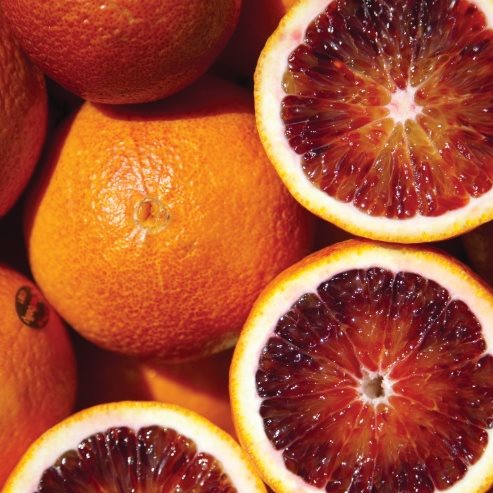Relatively new to the Australian fruit scene, blood oranges are packed full of vitamins and are the only citrus fruit to contain anthocyanins, which gives them their striking red colouring.
Sourcing
Originating from Sicily, Australian blood oranges are in season from late July through to November. They are grown around Australia, however in many places due to climate they do not develop the distinctive red colour inside. Warm days and cool nights are required for this unique pigmentation to develop, which reduces the range of premium growing areas to a narrow band of South Australia, Victoria and NSW. One region that excels in the production of heavily pigmented blood oranges is the Riverina of NSW, especially Griffith and Leeton which have almost the exact same climate as Catania in Sicily.
What's the appeal?
Apart from looking and tasting great, blood oranges are a powerful antioxidant, and have been proven to help prevent fat accumulation, sunspots and damage to the skin caused by UV exposure. There have also been studies that suggest that they reduce the damage to the body caused by smoking and air pollution.
Flavour matches
Blood oranges have a tangy citrus flavour with distinct raspberry notes. They work well with many flavours in both sweet and savoury dishes including:
- Chocolate
- Vanilla
- Cinnamon
- Ginger and stronger spices such as anise, cloves, chilli and various peppers.
Tasty applications
Early season blood oranges are quite tart which makes them perfect for use in savoury dishes in combination with fish, poultry and pork. The red flesh and juice of the fruit offers a unique freshness that cuts right through heavy flavours and brings a hint of sweetness. Early season blood oranges can also be used where lemons and limes are called for, like in cocktails and curds, but where a more delicate and nuanced flavour is desired.
Towards the middle and end of the season the tartness ebbs away allowing the raspberry notes to shine through, making blood oranges ideal for delicate desserts, jams, preserves and jellies.
Storage
Blood oranges are best stored in the refrigerator and will last for up to two months if kept in the crisper. A bonus to long term storage in the fridge is that due to prolonged exposure to the cold they will actually develop a more intense internal colour. Pop them in the fridge in November for use in Christmas ham glazes and cocktails.
Look out for
Smaller sized fruit, particularly early in the season, are more likely to be evenly pigmented and are best when a strong, striking colour is required for plating. Larger fruit can often have an opal like contrast of colours ranging between orange and deep crimson and are best used whole or in segments.. Also, external colour or blush is not a good indicator of internal colour. The best predictor of good internal colour is the region the blood oranges are grown in.
Recipe – Kingfish Carpaccio, Blood Orange, Fennel and Black Olives

- 600g Kingfish sashimi grade
- 3 blood oranges
- 2 baby fennel or 1 large fennel, remove the fibrous outside layer and wash.
- 100g black olives, pitted
- 40ml verjus
- 160ml olive oil
- 1 teaspoon lemon juice
- sea salt
- cracked black pepper
To make the dressing
First segment the blood oranges and set aside, then with your hand squeeze the juice from the segmented core.
In a small saucepan reduce 80ml of the blood orange by half, transfer into a bowl with 1 small pinch of sea salt, lemon juice, verjus and olive oil. Emulsify together using a whisk, set a side.
Remove the skin from the kingfish, cut out the blood line lengthways, releasing both the loin and belly fillets. Slice each fillet thinly and spread over the surface of a flat plate.
Shave the fennel thinly using a mandolin, and leave in iced water (to stop oxidisation) whilst cutting the pitted olives into rounds. Strain off the water from the fennel, and pat dry using absorbent towel.
Season the kingfish with salt & pepper, arrange both the shaved fennel, blood orange segments and black olives over the kingfish slices, just before serving dress the kingfish generously with the dressing. Best served five minutes after dressing.
Credit: Redbelly Citrus, redbellycitrus.com.au

